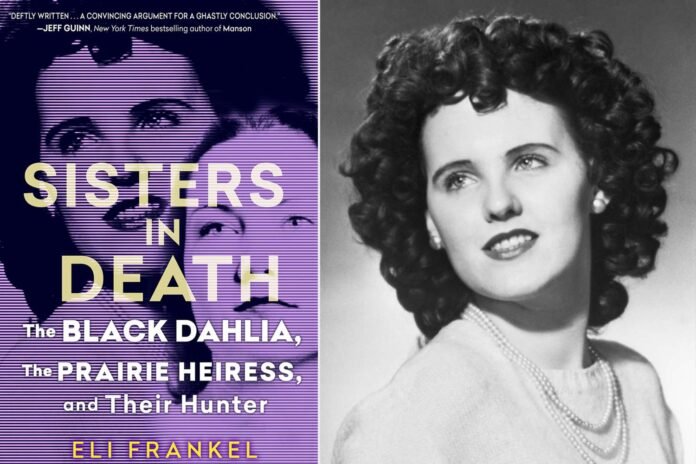NEED TO KNOW
- Hollywood insider and true crime skilled Eli Frankel breaks down why we’re all so obsessive about serial killers — and which of them seize our nationwide creativeness
- “Deep inside that terror of what others round us are able to, is the data that appears are deceiving,” writes the creator
- Frankel’s new e book, Sisters in Loss of life: The Black Dahlia, the Prairie Heiress, and Their Hunter by Eli Frankel is out there now
Right here’s a pop quiz: how most of the following names do you acknowledge?
Jeffrey Dahmer, Larry Eyler, John Wayne Gacy, Ted Bundy, Ronald Domanique, Patrick Kearney, Lonnie David Franklin Jr., Charles Manson, Ed Gein.
Except you’re a fanatical true crime historian, I’ll wager you didn’t acknowledge Larry Eyler, Ronald Domanique, Patrick Kearney or Lonnie David Franklin, Jr.
And but these 4 names characterize among the most prolific, horrifying serial killers in U.S. historical past. Why do you immediately acknowledge Jeffrey Dahmer, who killed 17 younger males and boys, and never Ronald Domanique, who killed 21 younger males and boys? Why do some killers achieve nationwide recognition and develop into an emblem of our best fears, whereas others rapidly drift out of the headlines, their faces and victims largely forgotten?
The reply is difficult. If the media chooses to extensively cowl a narrative it should achieve way more traction, creating lore and cementing the killer’s notoriety within the public thoughts. If a metropolis is terrorized by an lively serial killer for a prolonged interval — New York Metropolis and “Son of Sam” David Berkowitz, Los Angeles and “Evening Stalker” Richard Ramirez — recollections will linger for many years, guaranteeing the killer’s identify is repeated till it hits crucial mass. Generally a e book or documentary will revive the general public’s fascination with a dormant case. And generally superstar is the driving issue: OJ, Sharon Tate, Robert Blake, the Lindbergh child kidnapping.
However there may be one more reason sure killers grip the general public’s gaze and by no means let go. And it strikes on the coronary heart of the trendy mass fascination with true crime.
Regardless of our technological and social developments, people stay biologically wired for a unique period — our primitive, historic previous. The relative security and luxury of recent society has created a brand new actuality by which we anticipate and customarily don’t come into contact with different individuals intent on murdering us. Whereas gun deaths — particularly mass shootings — have had devastating results on society and instilled a pervasive concern, close-range, violent deaths by different means stay sudden and a distant risk. We don’t crouch and tiptoe into the grocery store in concern of a knife-wielding madman. We don’t go to a music pageant anticipating to be clubbed over the top and left to die. We don’t go to a cocktail party on guard for violence throughout the dessert course.
The truth was far completely different in early human historical past. Homicide was a standard incidence, for survival, for territory, for social competitors, competitors over sources and generally simply because we felt prefer it. Even inside shut, trusted teams, interpersonal violence was widespread. Lengthy earlier than the event of courtrooms, judges and regulation enforcement, punishment was meted out haphazardly inside tribes of people who lived with homicide, anticipated homicide. Over a whole bunch of hundreds of years, we have been hardwired to concern not solely nature, animals, illness and famine and floods, but in addition different people. It’s in our primal wiring.
And deep inside that terror of what others round us are able to, is the data that appears are deceiving. Somebody who seems “regular” might be hiding a monster behind the masks, able to make the transformation to killer at simply the precise alternative. Our primal wiring has stored us alive by our mutual suspicion of one another, our consciousness that some people might kill us for dominance, or for our meals or as a result of they merely need to. Even those who seem protected. Particularly those who seem protected. The problem has all the time been, and continues to be, figuring out who amongst us hides a killer inside. It’s as inherent to our survival mechanism as starvation or thirst.
This deep implant of suspicion inside our mind just isn’t dormant, however fashionable society has dulled it with the façade of “security.” Most of us have cell telephones that may dial 911 immediately. There are police stations blocks away, there are safety guards, metallic detectors, pepper spray, CCTV cameras, courtrooms to adjudicate severe disputes and luxury within the perception that vicious killers are far and few between.
The essential part widespread to the notorious serial killers everyone knows and grew up fearing, is the mixture of “normalcy” and horror. When the monster seems peculiar, socialized, snug amongst different individuals — identical to us — we listen. Once we are confronted with “a seemingly regular man on the block who buried 20 our bodies in his crawlspace,” our primal wiring lights up, responding to that repressed concern of the individuals round us, the individuals we work together with every single day, the individuals we stroll by in our residence constructing, or sit subsequent to on the subway.
What’s the headline of every extensively identified serial killer? Ted Bundy was a good-looking, charming lawyer, however was secretly… John Wayne Gacy dressed up as a clown and entertained the children, however was additionally … Charles Manson and his followers regarded like simply one other hippie commune however then they … Rex Heuermann was an architect in New York Metropolis and went out consuming along with his coworkers however within the basement of his suburban dwelling … Jeffrey Dahmer was a lanky, soft-spoken nerd however in his plain, one-bedroom residence … Each descriptor reads the identical: the monster lurking amongst us, seemingly considered one of us, however hiding one thing horrible.
Ed Gein gave the impression to be a mild-mannered farmer who did odd jobs round his Wisconsin small city within the Fifties. Everybody knew him. He even visited neighbors’ houses for dinner. He was additionally digging up graves, murdering native girls and stitching a go well with out of human pores and skin. His weird actions shocked the nation, however it was the looks of normalcy mixed with that horror that’s the intrinsic a part of his legend. That’s what individuals bear in mind — not solely did he do unthinkable issues, he appeared innocent for therefore a few years by everybody in the neighborhood.
Ed Kemper murdered 8 individuals, together with his personal mom, within the early 1970’s. However for many years after his conviction, Kemper remained comparatively unknown. Then, in 2017, the tv collection Mindhunter premiered on Netflix, and reintroduced the general public to the 6’9” behemoth, sending his identify and story into web infamy. What fascinates so many about Kemper in Mindhunter and in a YouTube collection of interviews he performed a decade after his killing spree, is his self-awareness.
Articulate and coldly trustworthy, he conducts a scientific dissection of his personal serial killer’s thoughts in service of understanding the psychopathy of all serial killers. Kemper turns into his personal psychologist, his personal profiler, and his insights really feel like a one-time backstage go into the serial killer’s thoughts. Engrossing and eye-opening, his compelling insights lay in unsettling distinction to the mindless, tragic acts of homicide he dedicated. Ed Kemper is the embodiment of the conventional/monster duality which connects us to our most base concern.
True crime is our psychological wrestling with the innate data of the human capability for homicide. Not like different animals, people don’t simply kill. We’ve intent, we make ethical selections. We homicide. Each time a real crime podcast or documentary sends a chill down our backbone, we’re receiving an historic sign from deep inside. “No person suspected a factor,” the crucial line that invades our thoughts, haunts our goals and connects us to that base concern of the individuals round us. The extra a killer’s profile presents each a façade we all know and a horror we can not start to grasp, the extra widespread they develop into. True crime followers are in the end related to not the seize of the killer, the trial and the imprisonment. They’re related to the profile of the killer themselves, the duality of normalcy and horror.
So, the subsequent time you watch a real crime documentary, obtain a podcast or learn a e book that makes your pores and skin crawl, bear in mind you’re not simply responding to a disturbing story. You’re connecting to one thing that has been deeply implanted in you, a warning out of your primitive ancestors to concentrate and be taught.
By no means miss a narrative — join ipromiseyoumedia’s free each day neighborhood to remain up-to-date on the very best of what ipromiseyoumedia has to supply, from superstar information to driving human curiosity tales.
Sisters in Loss of life: The Black Dahlia, the Prairie Heiress, and Their Hunter by Eli Frankel is out there now, wherever books are bought.




